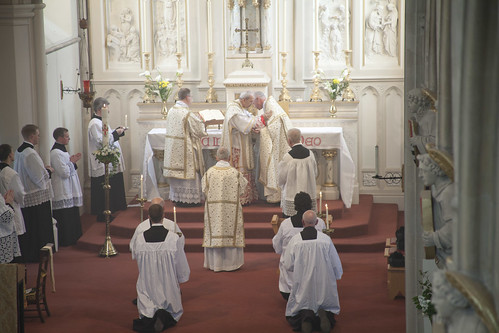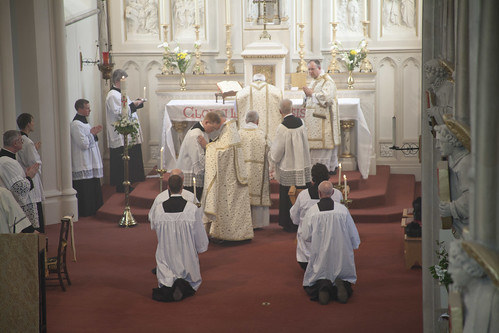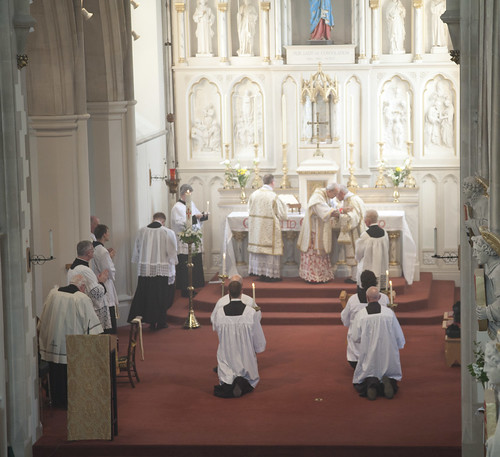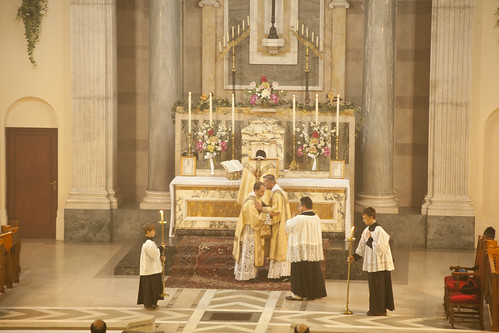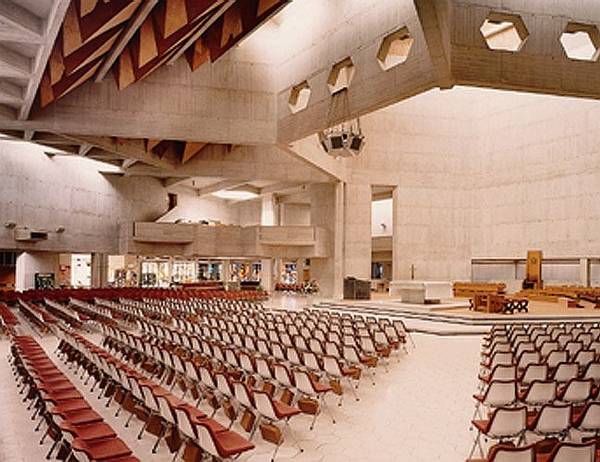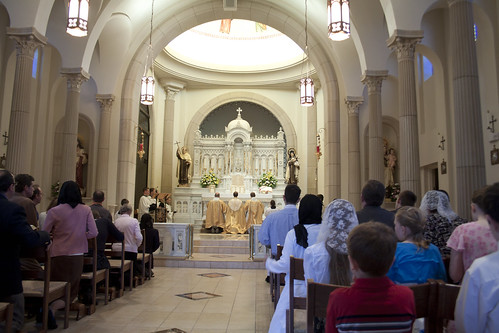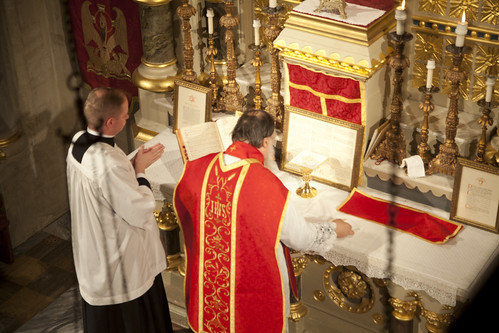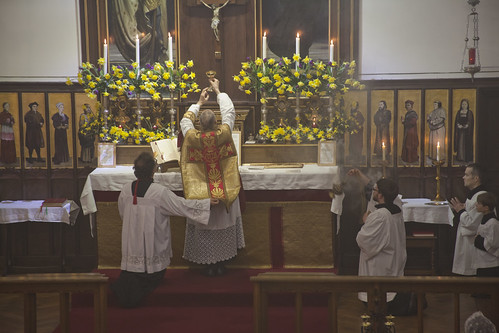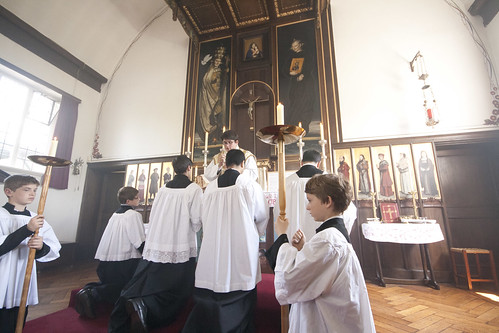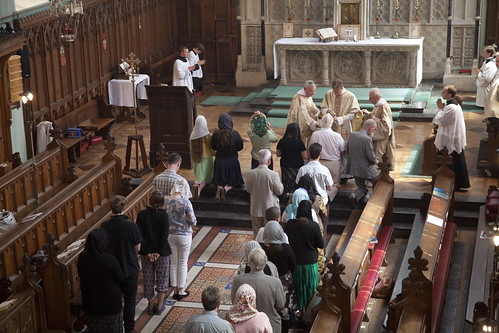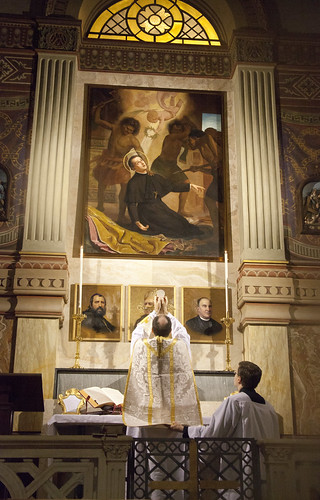 |
Fr Mark Withoos celebrates a Low Mass in the church of
the Domus Australia, under a picture of St Peter Chanel, a
a French Marist priest brutally killed in Tonga in 1841. He is
the protomatyr of Oceania. |
Reposted from August 2016
------------------------------------------
I wrote the below shortly after the killing of Fr Jaques Hamel, but for various reasons it's publication has been delayed until now.
The brutal murder of Fr Jaques Hamel in Normandy is the culmination of an extraordinary period of violence, even allowing for the tendency of the media to get into a rut of similar news stories. Even as an attack on a Catholic priest or a Catholic church, it was not as isolated as one might hope, since minor acts of violence are not usually reported nationally or internationally, but this represents a new low. The movement behind these attacks is not going to dissipate quickly on its own, and it is perfectly possible, indeed probable, that this kind of thing, at some level of intensity, is going to become part of our lives in the West, in the way that it is part of the lives of our Christian brothers in Pakistan, Egypt, Malaysia, and many other places.
To say that these events are meaningless, irrational, or incomprehensible, is not a way of understanding them: it is a way of refusing to understand them. In truth, they are none of those things. They are the logical outcome of an ideology which says that a Muslim can redeem a far-from pious life by attacking, abusing, terrorising and killing non-Muslims, or Muslims who fall below the ideology’s standards. The attacker’s own death can even be seen as a bonus, as it is imagined that he or she will immediately attain the promised, supernatural reward. There is no need for any close organisational connection between those bitten by this ideological bug, or training, or special equipment, although some of the recent attackers had some or all of these. In the
words of Fr Hamel’s killer, Adel Kermiche: “You take a knife, you go to a church, you make carnage, bam!”
It is a type of terrorism which is significantly different from those we have experienced in the recent past, but it is not entirely without modern European precedent. A parallel is offered by the anarchist assassins of the late 19th century. Like the Islamists, they emerged from a milieu (in their case, of left wing radicalism) in which most people, most of the time, lived fairly normal lives, and certainly weren’t constantly in danger of murdering people. Out of this milieu a few individuals got the super-radical bug, deciding that only assassinations were going to achieve their political goals. All they needed was an easily-obtained pistol or some dynamite; since they were careless of their own survival, they were very difficult to stop. Their ‘propaganda of the deed’ encouraged both admiration and imitation. Just as secular ideology inspired history’s greatest acts of mass-murder, so, in its day, it has inspired suicidal terrorism. It must be admitted, however, that there were only ever relatively tiny numbers of such assassins, and they generally chose only very specific targets.
I don’t have the expertise to offer specific policy suggestions in the face of this challenge, but I’d like to make two general observations about our response, the response of the target, Western societies, to the latest pattern of outrages.
The first thing to note, since it is being (apparently) denied by some, is that violence, and other forms of coercion, is certainly part of the solution. It is sometimes possible to stop unjust violence non-violently, but generally speaking it requires violence. I’m talking about violence and coercion by the forces of law and order, and occasionally private self-defence. Christ chose not to use violence to defend himself against the unjust actions of the public authorities of his own day; it is perverse to interpret this as undermining the right of public authorities to use violence justly. States may not neglect the necessary, violent, means to defend the populations which they are supposed to be governing. The state has the right and duty to employ violence, up to and including the right to kill, in war and in police action, for the sake of public peace. Public officials who refuse to defend the public by just and necessary means are not being noble; whether or not they are motivated by cowardice, they are doing grave wrong. Citizens and voters won’t put up with inaction, and nor should they. As far as the aggressors are concerned, a failure to use violence to oppose them is seen, correctly, as a sign of moral weakness, a sign that this is a society wide open to demolition.
So, within the limits of justice, we should support state action aiming to give effective opposition to terrorism. The danger of injustice here makes it all the more important to support just measures, or at least (if we disagree about their effectiveness), to make it clear that we do not regard them as unjust. If things get really bad, our societies are going to need to hear voices making a distinction between killing unjust aggressors and killing the innocent. If we have opposed every measure taken against terrorism, however mild and common-sensical, up to that point, no one is going to listen to us when they really need to.
A second, related, thing to note is that, while the cultural self-hatred of some on the political left is not a direct cause of terrorism, it is certainly making the situation worse. This goes beyond its manifestations in public policy. Outsiders see in the West a society which does not believe in itself, in its own values. As a society we suffer from the low self-esteem of the classic victim of bullying. In philosophical terms, there has been a move, over a number of centuries, from the substantive values of Christianity and classical culture, towards empty formalism. Instead of saying: ‘this is true’, ‘this way of life has value’, or ‘this work of art is good’, modern Westerners want to say: ‘nothing is true or false’, ‘only the choice between ways of life can be called good’, or ‘any purported work of art is good if they artist says so’. We can maintain for a little while a community of people committed to the notion of choice and the power of the individual to invent himself and set his own goals, but eventually people will ask: ‘If nothing substantive is true or good, why should choice or self-invention be true and good?’ There being no answer to this question, the whole thing turns out to be an empty charade. Even before the final, post-modern implosion of Western culture, there is nothing here for the soul to feed upon, there is nothing of substance to give society common values, there is nothing worth defending or promoting. People who possess nothing they regard as worth defending are not going to be very vigorous in its defence.
Here, there is something which can be contributed by people who still believe in something, something wholesome and historically rooted. Self-doubt and self-flagellation, even when offered by Christians, has nothing to offer the West; these are things already widespread in our societies. What we can offer is something substantive: that life, beauty, and God are real and have value, are worth something, and can give shape, discipline, and meaning to our lives. If Westerners really believed these things, and set themselves in their lives to live accordingly, then the Islamists would not be confronting such an easy and open target.
Support the work of the LMS by becoming an '
Anniversary Supporter'.
